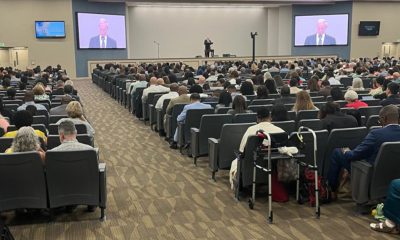Community
California Sen. Alex Padilla Introduces Legislation to Expand Higher Ed Opportunities for Latino Students
In honor of Hispanic Heritage Month, California Senator Alex Padilla introduced legislation initiatives to expand opportunities for Latino students in higher education and highlight Hispanic Serving Institutions (HSI).

By Magaly Muñoz
Post Staff
In honor of Hispanic Heritage Month, California Senator Alex Padilla introduced legislation initiatives to expand opportunities for Latino students in higher education and highlight Hispanic Serving Institutions (HSI).
The first part of the bipartisan legislation is being supported by Senators John Cornyn (R-Texas) and Bob Menendez (D-N.J) to establish the week of September 11th as National Hispanic-Serving Institutions Week, according to a press release from Padilla’s office.
Hispanic Serving Institutions make up about 23% of all colleges in California with another 47 emerging institutions. Colleges have to have 25% of their population be Latino or Hispanic students to be considered an HSI.
The second part of Padilla’s legislation, co-led in the House of Representatives by Representatives Joaquin Castro (D-Texas-20) and Jenniffer González-Colón (R-Puerto Rico), is the Hispanic Educational Resources and Empowerment (HERE) Act that looks to give resources to Latino students to bridge the educational gap.
Twenty-eight percent of Latinos have an associate’s degree or higher compared to that of their white counterparts with 48%. At two-year institutions, Hispanics’ graduation rate was five percentage points lower than that of their white, non-Hispanic peers and at four-year institutions, Hispanics’ graduation rate was 13 percentage points lower than that of their white, non-Hispanic peers, according to Exelencia in Education.
Padilla said the grants are tailored to help students through the application and transition process for college. The grants would also be put toward non-academic needs that deter students from achieving success in higher education.
“Our current education system has failed to sufficiently support Latino college recruitment and retention – just 28% of Latino adults have an associate’s degree or higher,” Padilla said in an email to The Post. “My legislation invests in both the educational and economic success of the next generation of Latinos in the workforce by creating a new federal grant program to fund partnerships between Hispanic-Serving Institutions and school districts with significant Hispanic and Latino enrollment to improve college readiness and completion.”
Some universities in California are already making changes to reflect the focuses that the HERE Act is looking to make.
San Francisco State University has a 36% population of Hispanic students enrolled in the school and initiatives are being made by leadership to help foster success for them.
SFSU President Lynn Mahoney said coming back to post-pandemic, in-person instruction in 2021 made her reflect on what more the university could be doing. She said being an HSI shouldn’t just be because of the chance of demographics, it should come with intention, and the campus should reflect the students’ needs.
“We recognize that students need to have faculty, staff and administrators that reflect their own ethnic and racial backgrounds. And this has not been easy in some cases. The pipeline is small,” Mahoney said.
Latinos makeup only 16% of staff and administration, and 9% of faculty, according to Robert King, the director of Communications at SFSU. Mahoney said STEM-related majors are where they’re lacking the most Latino and Hispanic representation.
Mahoney said some of the programs they have on campus are the Latino Student Success Center. Established in 2022, Spanish language orientations and a Center for Equity and Excellence in Teaching and Learning welcome educators to learn how to become culturally competent in their teachings when they have such a diverse class makeup.
“The future of California is our first-generation students of color, and Latinx students are the fastest-growing population here,” Mahoney said. “This state will only continue to be the best place in the world, if, in fact, we get college degrees into the hands of our Latinx students. So this is an investment that the state and every single citizen has to make.”
PIQE, or Parent Institute for Quality Education, is an organization that works primarily with high school students and parents, but has programs that address major gaps in education like STEM and offer transitional tools to help with higher education.
Andrew Ferson, the director of Policy and Partnerships at PIQE, said their “Family Bridge to College” looks to address what they call the “summer melt.”
“Summer melt is this idea that you have students who are accepted into and then intending to enroll in higher education, but then in the summer, for whatever reason they basically stopped going to or ended up not going to college,” Ferson said.
He said the program works with the districts and colleges to bring in families during the summer to foster the relationships early on and keep students on track with what they need for higher education. They’ve also partnered with UC San Diego to bring in professors and counselors to familiarize parents and students with resources and tools that the university offers.
Ferson said although they work primarily with high school families, a lot of the needs that parents are worried about – like digital divide and financing– can also be seen in college family concerns. He added that legislation, like what Padilla is introducing, is “smart policy” and addresses the relationship that colleges should have with families.
“I certainly hope that that bill gets passed and funded,” Ferson said. “But in the meantime, it’s on all of us to be actively reaching out to families and forming those relationships and meeting them where they’re at so that all of our students can succeed.”
Activism
Oakland Post: Week of July 24 – 30, 2024
The printed Weekly Edition of the Oakland Post: Week of July 24 – 30, 2024

To enlarge your view of this issue, use the slider, magnifying glass icon or full page icon in the lower right corner of the browser window. ![]()
#NNPA BlackPress
NNPA NEWSWIRE — Reflecting on his long career, Biden expressed deep gratitude and pride. “Nowhere else on earth could a kid with a stutter from modest beginnings in Scranton and Claymont one day sit behind the Resolute Desk in the Oval Office. But here I am. That’s what makes America special,” he remarked, his voice tinged with emotion.
The post first appeared on BlackPressUSA.

Biden: Our Democracy Demands New Leadership
By Stacy M. Brown, NNPA Newswire Senior Correspondent
@StacyBrownMedia
In an impassioned address from the Oval Office, President Joe Biden laid bare his decision to step down from the 2024 presidential race, urging Americans to embrace a new generation of leadership. “Saving democracy is more important than any title. It’s time to pass the torch to younger voices,” Biden declared in an address that signaled a transformative shift in American politics.
Following his decision over the weekend to bow out of the race for re-election, Biden’s announcement was a clarion call for renewal. Stressing the moment’s urgency, Biden emphasized that the future of democracy depends on fresh, dynamic leadership. He endorsed Vice President Kamala Harris as the embodiment of this new era. “Years ago, I described myself as a transitional candidate, and now it’s time for that transition to take full effect,” Biden said, positioning Harris as the future of the Democratic Party.
While refraining from mentioning former President Donald Trump by name, Biden clarified that he views the twice impeached and 34 times convicted felon Republican presidential nominee as a fundamental threat to democratic values. “My record as president, my leadership on the global stage, and my vision for America’s future all merited a second term,” Biden stated. “But nothing can stand in the way of safeguarding our democracy. That includes personal ambition. So, I’ve decided the best path forward is to pass the torch to a new generation.”
Reflecting on his long career, Biden expressed deep gratitude and pride. “Nowhere else on earth could a kid with a stutter from modest beginnings in Scranton and Claymont one day sit behind the Resolute Desk in the Oval Office. But here I am. That’s what makes America special,” he remarked, his voice tinged with emotion.
Biden acknowledged that doubts about his ability to defeat Trump influenced his decision. “I revere this office, but I love my country more,” he said. “It’s been the honor of my life to serve as your president. But in defense of democracy, which is at stake, I think it’s more important than any title.”
Biden said he is determined to address crucial issues for the remainder of his term. His agenda includes lowering family costs, defending personal freedoms, protecting voting rights, combating cancer, addressing gun violence, and advocating for Supreme Court reform. Internationally, he said he aims to strengthen NATO, support Ukraine, and seek an end to the conflict in Gaza.
Biden’s endorsement of Harris has galvanized the Democratic Party, with Harris swiftly securing the backing of a majority of Democratic delegates. “I’m not going anywhere,” Biden reassured his campaign staff, now supporting Harris. “I’m going to be out there on the campaign trail with her, working tirelessly as both a sitting president and a campaigner.”
The landmark address, along with Biden’s anticipated speech at the Democratic National Convention, could prove pivotal in defining his legacy. “In a few months, Americans will decide the direction of our nation’s future,” Biden stated. “I have made my choice. I’ve expressed my views. Now the decision is in your hands, the hands of the American people.”
In the days before his decision, Biden confided in close advisors about his concerns regarding another run against Trump. His acknowledgment of those doubts underscored his commitment to putting the country’s needs above his ambitions. “The defense of democracy must come before all else,” he reiterated.
As Biden prepares to support Harris in her campaign, he remains focused on his presidential duties. His administration continues to push for significant legislative achievements, reinforcing his enduring commitment to the American people. “In just a few months, the American people will choose the course of America’s future,” Biden said. “The great thing about America is here, kings and dictators do not rule. The people do. History is in your hands. The power is in your hands. The idea of America lies in your hands.”
The post first appeared on BlackPressUSA.
#NNPA BlackPress
PRESS ROOM: Reparations Movement Partners Globally Mourn the Passing of U.S. Congresswoman Sheila Jackson-Lee
NNPA NEWSWIRE — we acknowledge the powerful legacy of U.S. Congresswoman Sheila Jackson-Lee. She was a steadfast leader in the fight for reparatory justice, carrying forward the legislative baton from the late U.S. Congressman John Conyers in 2018.
The post PRESS ROOM: Reparations Movement Partners Globally Mourn the Passing of U.S. Congresswoman Sheila Jackson-Lee first appeared on BlackPressUSA.

[July 22, 2024 – Chicago, IL] With an extremely heavy heart and a profound sense of loss, we acknowledge the powerful legacy of U.S. Congresswoman Sheila Jackson-Lee. She was a steadfast leader in the fight for reparatory justice, carrying forward the legislative baton from the late U.S. Congressman John Conyers in 2018. Her relentless efforts nearly brought HR 40 to passage in the House of Representatives in 2022, missing by just one vote. Her leadership was pivotal in advancing the bill out of the Judiciary Committee in April 2021 after a historic debate. Even after her diagnosis, Rep. Jackson-Lee fiercely collaborated with reparations leaders, pushing for President Biden to establish an HR40-like commission by Executive Order. She believed this executive path was crucial for addressing centuries of injustice. Despite setbacks in meetings with the President’s team, she remained optimistic and urged us to stay ready for progress.
The Earn the Black Vote Collaborative formed in 2023 in response to her urging to continue the fight for reparations. On April 25, 2024, the Collaborative released a poll showing significant support for President Biden to issue an Executive Order for Reparations. Congresswoman Jackson-Lee championed the poll’s findings, emphasizing the critical importance of reparations to African American and progressive communities. Her vision was clear: an Executive Order to create a federal reparations commission could drive transformative Black voter turnout and move the ball toward justice. She had wanted the Executive Order done by Juneteenth. Tragically, just a month after Juneteenth, she left us. We have lost a great leader for reparatory justice. In honor of her legacy, we call for the establishment of the Executive Order by President Biden. We extend our deepest condolences to Representative Jackson-Lee’s family. We call on reparation activists, leaders, and legislators globally to stand with us as we honor her legacy. May the Ancestors and the Creator receive her with joy.
About the Author:
Kamm Howard is a national and international reparations scholar and activist working for over 20 years building grassroots movements to obtain reparations for African descendants in the United States.
CONTACT:
Reparations United Phone: 773-985-2990
Email: kamm@reparationsunited.org Website: https://reparationsunited.org/
The post PRESS ROOM: Reparations Movement Partners Globally Mourn the Passing of U.S. Congresswoman Sheila Jackson-Lee first appeared on BlackPressUSA.
-

 Arts and Culture3 weeks ago
Arts and Culture3 weeks agoRooted in Tradition: The Intricate History of Black Hair Braiding
-

 Bay Area4 weeks ago
Bay Area4 weeks ago“I Will Not Be Bullied,” Says Oakland Mayor Sheng Thao
-

 Bay Area2 weeks ago
Bay Area2 weeks agoPG&E Increases Rates While Bay Area Households Are Struggling to Stay Afloat
-

 Business3 weeks ago
Business3 weeks agoGov Newsom: Raising Fast Food Minimum Wage to $20 Pays Off as Jobs Multiply in Industry
-

 Activism4 weeks ago
Activism4 weeks agoOpponents of Mayor Sheng Thao Are Calling on Her to Resign Following FBI Raid
-

 Community1 week ago
Community1 week agoHundreds Come to Jehovah’s Witnesses’ Assembly Hall for Three-Day Program of ‘Good News’ in Fremont
-

 Bay Area2 weeks ago
Bay Area2 weeks agoJuneteenth Mass Shooting Suspect Charge with Multiple Counts of Felony Assault by Alameda County DA Pamela Price
-

 Activism4 weeks ago
Activism4 weeks agoOakland Coliseum Sale to AASEG: A Model for Community Development and Inclusion






















































